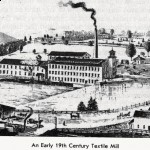Factory Legislation
Category: 19th century
When the facts about factory conditions became generally known they shocked the most part of the early nineteenth century Englishmen, and agitation for the prohibition of some of the worst abuses was started.
As early as 1800-1815, in the years during which he managed the New Lanark mills, Robert Owen had shown that output was not in direct proportion to the number of hours worked, and that it was possible to work a 10 1/2 hour day, to do without the labour of very young children, and yet to make substantial profits. With the development of faster, more accurate, more powerful, and more costly machines and with the substitution of steam power for water power, the advantages from a very long working day became less. It was always the water power mills where hours and conditions were the worst and whose owners put up the most stubborn opposition to any kind of change.
More capital was sunk in machinery, and the relation between the capital so used and the capital used for the payment of wages gradually changed. The amount of actual manual labour needed to produce a given article decreased, and at the same time the speed at which the new machinery would work became increasingly greater than the speed at which men could work for a day lasting for sixteen or eighteen hours. It became less economical to work the machine at part speed over a long day than at full speed over a shorter one.
The first legislation, passed in 1802, was a very mild act to prevent some of the worst abuses connected with the employment of pauper children. It was followed by the Cotton Factories Regulation Act of 1819 which forbade the employment of children under nine in cotton factories and limited the hours of those between nine and sixteen to 13 1/2. As no machinery was ever provided for the enforcement of this Act it remained a dead letter.
It was not till 1833, after the passing of the Reform Bill and under pressure of the workers that an effective Act was passed. This prohibited the employment of children under nine except in silk factories, limited the hours of older children and provided a number of inspectors to see that these restrictions were carried out.
Finally in 1847 the Ten Hours’ Bill limited the hours of women and young people, and, in practice, secured a ten hour day for most of the men, since it proved unprofitable to keep the factories open for them alone. This result was not achieved for some years, however, during which the employers tried every conceivable evasion and device short of flat defiance of the provision of the Act.
These Acts applied only to the textile industries. They did not apply, for example, to mining, and the Mines Commission of 1842 disclosed that the conditions had actually become worse since the Act of 1833 had resulted in an increase of child labour in the mines, especially in Lancashire. The fact was that the wages of adult workers were so low that parents were forced to put their children into any occupation that was open for them.
Before each Factory Act was passed, the employers were full of insuperable difficulties, of things that had always been done by child labour and could not be done otherwise. Afterwards it was quickly found that machines could be devised to do the same work, usually with a saving of labour and production costs. Thus, for example, the extension of the Factory Acts to the match industry resulted in the invention of a dipping machine, which made the manufacture of matches much more healthy and at the same time, in one factory, enabled 32 young workers to do the work which had previously required 230.
If the Factory Acts led to the use of more and better machinery, this result was not uniform. Introduction of a new equipment might have unforeseen consequences. Sir Humphry Davy, the inventor of the Davy’s safety lamp, refused to take any royalties for what he regarded as his gift to humanity. He hoped to prevent explosions in the mines. The lamp was quickly and widely adopted, but that led to an increase in the number of accidents, since the owners were able to open up deeper and more dangerous seams, and, in many cases, the existence of the lamp was made an excuse for not providing proper ventilation.
Only the larger and more prosperous enterprises were able to carry out the necessary changes in such a way as to increase their profits. The factories that were already the most obsolete, and especially the old water-power mills, could not be adapted to meet the new conditions. Some went under or were absorbed by richer firms, but their disappearance did not mean that the industries as a whole declined. On the contrary, the Factory Act led to in increase in industry by providing a stimulus to the adoption of more efficient methods and at the same time led to the emergence of great and most modernized firms. This legislation actually helped the larger concern to drive the smaller one out of the market.
Factory Legislation was a necessary part of that development which included the displacement of water power by steam, the wholescale use of machinery to manufacture not only consumption articles but the means of production themselves and the transfer of the decisive point in production from the small to the large unit.
